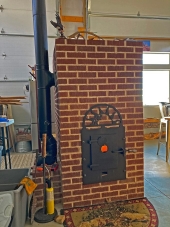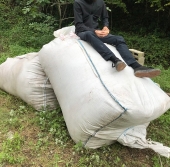


Solar Station Construction Plans by Ben Peterson -- ebook
will be released to subscribers in:
soon!











Check out Redhawk's soil series: https://permies.com/wiki/redhawk-soil

 1
1




List of Bryant RedHawk's Epic Soil Series Threads We love visitors, that's why we live in a secluded cabin deep in the woods. "Buzzard's Roost (Asnikiye Heca) Farm." Promoting permaculture to save our planet.




Derick Greenly wrote:Ahoy!
For the combined purposes of: (1) spawn production beyond what a bedroom closet can handle; and (2) season-extending indoor production of select species of fungi (in reusable containers-don't you worry!), I intend to repurpose our defunct silo foundation room and adjoining "feed room" as a growroom and mycological lycaeum. Pooling from E&E's annex plan and the BIG BOOK, I'd like to install a rocket mass heater which spans both rooms, thus heating the growing area and running spawn-heating vessels using the readily available wood fuel of our Great Lakes biome. As shown in this picture, my intend is to have the feed tube and barrel just inside the work room, passing the ducting through into the spawn house, around one of the 2 monolithic walls, back into the work room, up and away! The bench will look like a flattened quarter-round tucked against the wall. I accept that I'll have to step over the thing repeatedly. I intend to use the warmer (inner) area for spawn run, the 2nd warmest area (RH outside) for fruiting (this means it should be closed off to contain a humidity spike, yes?) and the barely-heated area for either finished-spawn holding or to become my clean-room/lab.
I would put my lab and flow hood out in the workroom, but its ability to be kept clean and still is a distant second to the spawnhouse. Thoughts on this matter are welcome.
The old silo above will be sealed off by means of silicone applied over the edges of the steel door which opens through the ceiling.
Thoughts? Glaring flaws? Where will the concrete room fall in the thermal mass/heat sink/heat robber spectrum? 8 inches thick on all sides, I believe. Any cleaning concerns with cob at ~100% RH for several months? Will the residual old corn, of which I'll probably never scour away all traces, present an insurmountable contamination spore load?
Thanks in advance!
Derick









Derick Greenly wrote:It'll be a J-tube, certainly. I'll be working closely on the cooktop most times it's in use and be happy to feed to suit my needs.
As for Drake's caution, I do thank you. But my thought for a little while now has been: grain bags in anyplace but a filtered, clean incubation room? A touchy nuisance! Who needs it? My work will consist of:
-Grain spawn in jars (I can hold enough grain spawn in both arms to spawn enough substrate to half-fill this space and then spawn a mess of logs. Half gallon and quart jars will do fine, and reliably.
-Sawdust substrate bags, straw substrate bags and sawdust spawn bags for logs and rafts outdoors (this is where my use of "spawn" maybe threw you off).
I have previously and successfully grown many jars of Liquid culture and grain spawn in a drafty area with a nice fat spore load. Please let me know if you'd still worry about sawdust in bags in an environment like this. I suppose my observation of (other people's) Stropharia, Shiitake, Oyster and Elm on pasteurized substrate in (essentially) humidified semi-outdoor conditions has instilled quite a confidence in me in this regard.




















 1
1




 1
1




 1
1





|
A sane person to an insane society must appear insane. - Vonnegut
Freaky Cheap Heat - 2 hour movie - HD streaming
https://permies.com/wiki/238453/Freaky-Cheap-Heat-hour-movie
|







